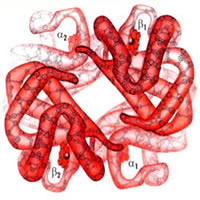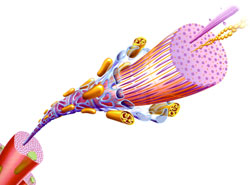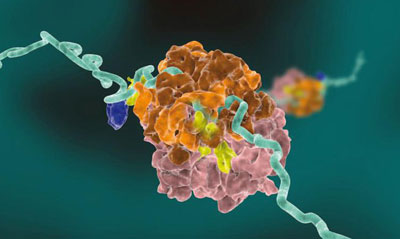 |
| The complex design of the haemoglobin molecule |
 |
| Cytochrome-C Protein |
Proteins are the building blocks of the cell. If we compare the cell to a huge skyscraper, proteins are the bricks of the skyscraper. However, they do not have a standard form and structure as the bricks do. Even the simplest cells have roughly 2,000 different types of proteins. If cells can survive, it is thanks to the extraordinarily harmonious functioning of these distinct proteins.
Proteins are made up of smaller structures, or molecules, called "amino acids", which are formed by the different combinations made by carbon, nitrogen and hydrogen atoms. There are 500-1,000 amino acids in an average protein. Some proteins are much bigger.
The important point is that amino acids have to line up in a certain sequence to form a protein. There are 20 different amino acid types used in living organisms. These amino acids do not combine at random to form proteins. Every protein has a certain amino acid sequence and this sequence must be precisely matched. Even the deficiency or the replacement of a single amino acid renders that protein a useless lump of molecules. For this reason, every amino acid must be just at the right place in the right sequence. The instructions for this sequence are stored in the DNA of the cell and, according to them, the proteins are produced.
 | THE ARCHITECTURE IN PROTEINS Besides having a sophisticated design, proteins are also involved in a great design in the body. The human body is mainly composed of proteins. Proteins are the basic material of our bones, eyes, hair or muscles. Here, you see the complex interior structure of a single fibre in one of our muscles. Cells with different protein make-ups form each of the details you see in this structure. Every detail is perfectly designed and built by the use of an organic material, which is protein. The fascinating architecture of proteins is one of the striking signs of creation. |
The theory of evolution claims that the first proteins formed "by chance". Probabilistic calculations, however, show that this is by no means possible. For instance, the probability of the amino acid sequence of a protein made up of 500 amino acids being in the correct order is 1 in 10950.5 10950 is an incomprehensible figure formed by placing 950 zeros after 1. In mathematics, a probability smaller than 1 over 1050 is considered to be almost impossible.
Briefly, even a single protein cannot form by chance. Evolutionists also admit this fact from time to time. For instance, Harold Blum, a famous evolutionist scientist, states that "the spontaneous formation of a polypeptide of the size of the smallest known proteins seems beyond all probability."6
 | PROTEIN SYNTHESIS There is a continuous activity going on in our cells: the proteins in the food we eat are broken down and these pieces (amino acids) are re-combined according to the codes in DNA. Thus, new proteins needed by the body are made. This operation, called the protein synthesis, is far more complex than this simplified illustration. No laboratory is as successful as the cell in carrying protein synthesis.
|
So, what does all this mean? Perry Reeves, a professor of chemistry, gives the answer:
When one examines the vast number of possible structures that could result from a simple random combination of amino acids in an evaporating primordial pond, it is mind-boggling to believe that life could have originated in this way. It is more plausible that a Great Builder with a master plan would be required for such a task.7
 | CAN MONKEYS WRITE A BOOK?
Cytochrome-C is one of the most important proteins that make oxygen respiration possible. It is vital for survival. It is impossible for this protein, which has an extremely complex design, to form by chance. One of the foremost defenders of evolution in Turkey, Professor Ali Demirsoy states in his book Inheritance and Evolution that the probability of the coincidental formation of Cytochrome-C is "as unlikely as the possibility of a monkey writing the history of humanity on a typewriter without making any mistakes."8
|
5) Lesen Sie bitte Harun Yahya, Der Evolutionsschwindel, Okusan Verlag, 2002, S. 149
6) W. R. Bird, The Origin of Species Revisited, Nashville: Thomas Nelson Co., 1991, S. 304
7)J. D. Thomas, Evolution and Faith, Abilene, TX, ACU Press, 1988. S. 81-82
8) Ali Demirsoy, Kalitim ve Evrim (Vererbung und Evolution), Ankara: Meteksan Publishing Co., 1984, S. 64